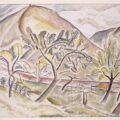In Another Country with Michelle Bailat-Jones

Dangling like a geologic afterthought at the southwestern tail of Japan’s archipelago, Kyushu Island is home to over thirteen million people and a chain of volcanic mountains. In the slopes, valleys, towns, and forests below Fog Island Mountains—called Kirishima after one of the highest peaks, which reaches nearly 6,000 feet—the “normal” weather pattern includes, on average, ten typhoons a year. Michelle Bailat-Jones’s debut novel, Fog Island Mountains, emerges with uncommon grace from a world subdued by nature, to speak of love, exile, betrayal, illness, and death. It is rare for a first novel to take on such vast and slippery terrain—much less to conquer it.
The novel unfolds over just a few days, with each chapter following one of the seven phases of a typhoon’s trajectory. This imminent “weather event” provides both the architecture of the narrative and its over-arching metaphor, to say nothing of the colors, mood, and tone it offers. The first chapter, “Disturbed Weather,” opens in the invented mountain community of Komachi. An expatriate Australian English teacher, Alec, past middle age, gazes from a hospital window as he listens to his Japanese doctor explain that cancer “…has spread already, that it has moved to other places in Alec’s body. He is saying they believe it is everywhere.” Throughout the pages that follow, the notion of “everywhere” becomes a poetic echo, an everyday term that’s orchestrated to recall the moment when Alec Chester’s life and outlook shifts inexorably, and his struggle to relocate himself begins.

Fog Island Mountains
By Michelle Bailat-Jones
Softcover, $17.95
Tantor Media, 2014
Essential to his process is Alec’s Japanese wife of forty years, Kanae, who is expected at the hospital but does not come. Instead, she runs in the opposite direction—away from the “everywhere” she cannot escape, away from the hospital where Alec is waiting, away from the certainty of his death. On a superficial level, Bailat-Jones’s plot traces the chaotic separation of Alec and Kanae in the face of impending disaster. But if there is wisdom to be gained in the juxtaposition of Kanae’s nonstop but futule activity against Alec’s increasing passivity and helplessness, this does not cohere to form the essence of the novel.
The deeper wisdom of Fog Island Mountains is situated elsewhere. It emerges from the gathering of stories, echoes, memories, and rituals, all narrated by the sort of transformative figure who’s often found in long-told folk tales: an elderly woman who lives alone in the forest and cares for wounded animals. This ubiquitous narrator, Azami, knows everything about Alec and Kanae. She seems to know about everyone. As a literary device, she is a kind of griot, a poet whose role is to hold atavistic and collective memory intact. As a reminder of the writer’s craft, she is the voice of Bailat-Jones imagination—and perhaps her alter-ego. As a character, she is at once a witness and a healer whose presence is so familiar that she has achieved the enviable invisibility of ghosts and angels.
Even if Azami occasionally conceals herself in the objectivity of a third-person perspective, she is more than a traditional omniscient narrator. She is also a character embedded in the community. Azami speaks most often of “our Komachi,” in the present tense. This dual nature of the narration, as both personal and semi-objective (or seemingly objective) presents a challenge to readers of Fog Island Mountains. The immediacy of Azami’s voice is engaging, and it encompasses both personal mysteries as well as Japanese Kitsune folk tales about deceptive “fox spirits” hidden in particular women. In an exquisitely-described tea ceremony, in the chapter titled “The Eye,” Azami becomes the quiet center of the stormy world as well as its healing spirit. Only creative readers open to such mysteries will trust Azami’s multiplicity as she prepares to “pour the hot water into the black kettle and clear my mind, clear everyone away for just this moment” before she enters that strange, all-knowing space in which all life exists, including the life of the reader, as if in the protective steam of Azami’s kettle:
A hum really, that’s all I need. But a gentle hum at the back of my mind and I can create the proper emptiness. Hear it? The animals hear it; they have quieted in their cages. Everyone hears it. Alec in the lobby of his inn, tense and focused. Kanae on her bicycle, no longer heaving, now able to breathe. Listen to it. It ripples behind our ears while I cross the tatami floor, rumbles softly in our minds while I kneel before the kettle and pour the hot water. It vibrates about us while I sit, quietly now. With this hum I leave everyone else’s story to its peaceful pause. The storm has surrounded us; here, at its quiet center, we are at a stop.
Having reached this “stop,” Azami proceeds to kneel on the floor “so that my body becomes its own special character, a moji that is an alphabet letter of myself, the me who is here only to prepare this tea, the me that means peace.” But she never forgets that the reader is there too, the reader who suddenly becomes a student and witness in an almost mystical overlay of imagery:
Listen to the quiet. Now I move the bowls—still we are humming, silently, a vibration of air between us—I place the bowls before the kettle, lingering with my fingertips on the grain of the pottery, on the tiny raised ridge of the blue glaze…. Now it is ready, now I am ready. Again, we must not forget to breathe. I clean the natsume, I clean the tea spoon. Gently now. Oh so gently. And the instruments begin to hum with us. The woven floor and my knees against the weave, my straight back and the parallel scroll hanging against the wall, the fragile bamboo and the steam of water in the kettle. Everything hums.
Take your eyes off of me and look at Alec standing in the lobby of the inn. I am pouring the hot water and he is not in pain, just for this moment, just now we are paused. And Kanae on her bicycle has started listening to the gentler wind in the trees, to the drops of water falling from the leaves, this typhoon music and her mind is empty and her heart is quiet. And my mind is closed. I pour the hot water. I rinse the bowl. I am making us all clean again.
Bailat-Jones, who was born on Kyushu Island and is fluent with Japanese culture, also challenges her readers with a structure that absorbs and re-negotiates the meter of epic chōka poetry, a feature she referred to as “a secret part of the book” in a Library Journal interview. A less secret, but equally complex influence, is the European tradition of the rural novel that tends to invite an “East meets West” comparison. Beauté sur la terre (Beauty on Earth) by Swiss writer C. F. Ramuz (1878–1947), which Bailat-Jones translated into English in 2013, bears similarities to Fog Island Mountains. Both are set in somewhat remote geography and both reach for eternity—in parallel notions of Alec’s “everywhere” and Ramuz’s “elsewhere”—but most importantly, both culminate in a disastrous storm whose fury announces the inevitable departure of a foreigner.
In Fog Island Mountains, it is Alec’s foreignness that unravels and eventually dissolves as he reaches the end of his life. Apart from Alec, Kanae, and Azami, the characters are anonymous or fragmentary figures: neighbors, nurses, innkeepers, and even the old friend with whom Kanae makes love, are mere markers along the fine line between familiarity and foreignness, bowing, smiling, and staring “…just a beat too long, as Japanese people sometimes do.” Bailat-Jones’s secondary characters know very little about each other and they tend to keep their distance. The startling moment when two figures, observed by Alec in the garden of an outdated inn, appear to him as “statues, or carved puppets, petrified, silent, and unmoving” is one of the novel’s most brilliant depictions of alienation. Though beautifully drawn, Alec and Kanae’s three grown children are similarly distant, each marked with a sense of exile that, we know, will somehow be resolved by Alec’s death.
Michelle Bailat-Jones won the 2013 Christopher Doheny Award for Fog Island Mountains from The Center for Fiction in New York, a prize established to honor a novel with illness as a central theme. However, it may come as a consoling surprise that the novel is not actually focused on illness. Rather, it explores the healing and acceptance that are released through the power of storytelling, embodied by the image of Azami releasing a badger from the confines of a cage. Illness, most certainly, is a kind of cage from which humans need to be released. The intricate, frustrating cages of malfunctioning bodies are neither objects of fascination nor of fear in the novel, as they often are in life.
“Alec has been such a perfect foreigner—he has never surprised us in the wrong way,” Azami explains to the reader. A few pages later she adds, “Even in his death he will be a foreigner, somehow this comes as a comfort to Alec.” This last sentence might be read as a kōan, those riddles best known to students of eastern religion, because it holds within its apparent contradiction a fundamental truth. However foreign death may be, the end of life—like the end of a good story—carries the reassurance of a shared human condition.
As the storm subsides in “Landfall,” Alec and Kanae find each other—at last—at a familiar shrine in the forest. He bumps his head on a ledge, a small “event” that prompts Azami to observe that this is “the last time he will feel like a giant in our midst.” Alec has already entered another country, a place where “everywhere” is no longer internal but eternal. He has weathered the storm and conquered many mountains, and so Azami can turn her attention to other stories. Fog Island Mountains is a fearless first novel, and its readers, no doubt, eagerly await the stories that Michelle Bailat-Jones turns to next.
Photograph © William Cho
About Patti Marxsen
Patti M. Marxsen is the author of Jacques Roumain : A Life of Resistance (Caribbean Studies Press), which shared the 2019 Book Prize of the Haitian Studies Association.





